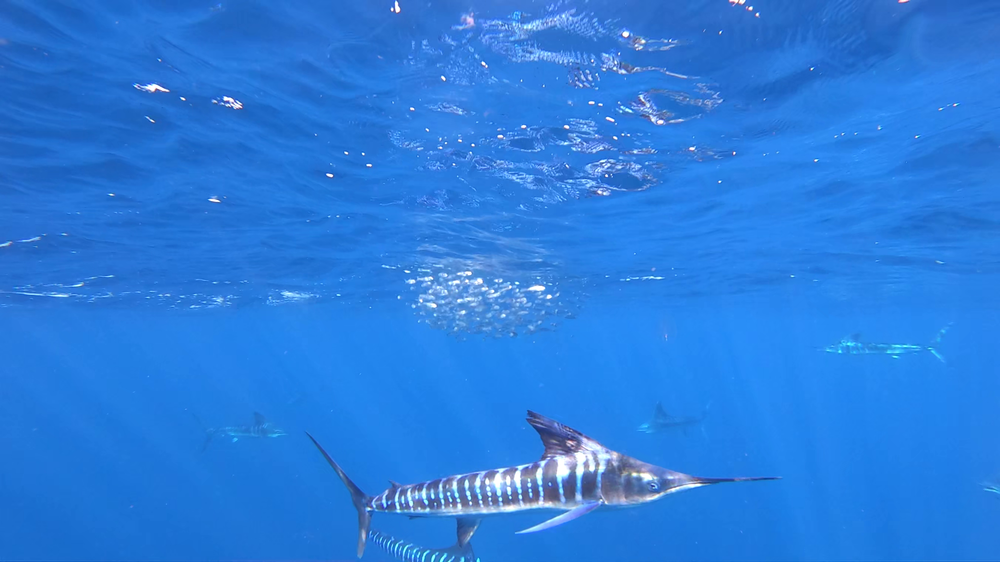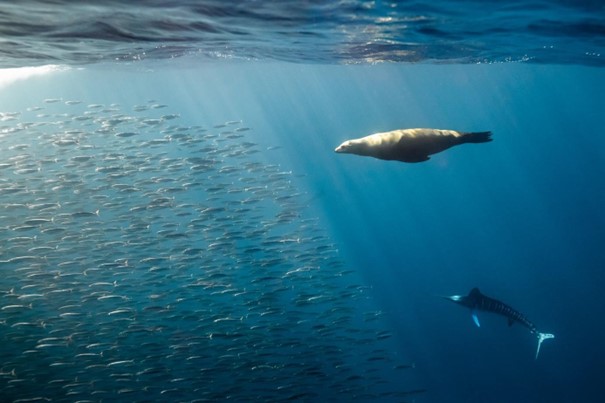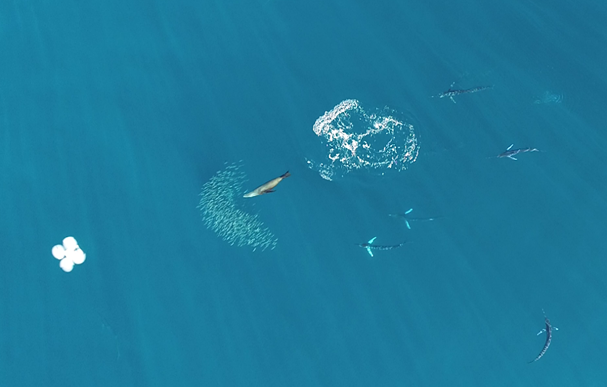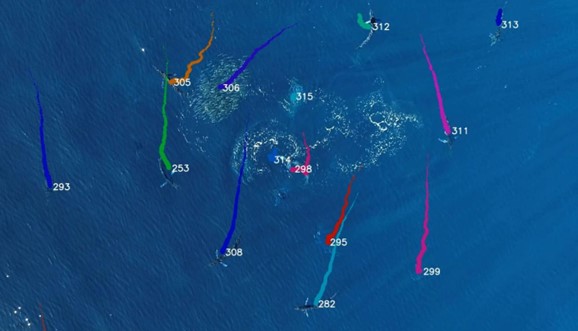First to the Feast

Figure 1.
Sailfish use their rostra to slash and tap sardine schools, often injuring many sardines to enable easier capture not only for themselves, but also for their groupmates (pictures off Cancũn, Mexico).
Multi-species aggregations in the open ocean are one of nature’s most spectacular sights. Diving birds, large pelagic predators, and even the occasional whale circling a fish school, have long been the fodder of nature documentaries and wildlife enthusiasts. But, unlike their terrestrial counterparts, the ephemeral nature of these aggregations, coupled with the difficulty of filming at sea, has meant that there is a lack of scientific information detailing how and why they come about. To that end, with an ever- expanding team across several countries, we are beginning to unpick the many facets of marine predator aggregations with the aim of understanding the selection pressures that govern these multi-species spectacles.
Billfishes
Billfishes, such as sailfish, swordfish and marlin, are among the ocean’s most impressive predators. Our team has conducted research on billfishes for well over a decade off the coast of Mexico, starting with sailfish in Cancún (Fig. 1) and moving to our current focus of striped marlin off Baja California Sur (BCS). Our primary aims have been to understand what selection pressures might have led to the evolution of their elongated rostra and how (and why) these species hunt in groups. Billfish have fine-tuned their hunting technique with behavioural, morphological, and physiological adaptations, so a multidisciplinary approach has been vital to unpicking these questions.
Finding billfish aggregations typically follows the same pattern—we venture far offshore in search of bird flocks indicating locations where predators have pushed fish schools to the surface. Avian predators such as frigate birds, boobies, or pelicans, are common and typically not a problem for our investigation into billfish behaviour; their occasional snatching of a fish does not appear to have a big impact on what is going on under the surface. This contrasts with cetaceans and sea lions, which also regularly turn up in pursuit of easy prey. The larger species, like bottlenose dolphins, can be especially disruptive by beating their tails into the fish school, effectively destroying it, and quickly consuming the remnants. Therefore, from the perspective of the billfish research, the arrival of other large predators usually meant that for us the ‘show’ was essentially over, and for the first few years of our research we regarded other marine predators as little more than a nuisance when they turned up.
However, the regular occurrence of these multi-species predator aggregations has led to a shift in our focus over time, and eventually we became curious to understand how the other marine predators not only interact with the prey schools, but also, crucially, how the different predator species interact with each other.

Figure 2.
Striped marlin, usually solitary, form large groups when hunting, often encircling and shepherding a bait ball to keep it at the surface (seen here off Baja California, Mexico)
Producers and scroungers
In terrestrial ecosystems, predator aggregations around carcasses have been the subject of considerable research, particularly in regard to producer/scrounger relationships, dominance hierarchies, and kleptoparasitism. Surprisingly though, little is known about the relationships of different predator species in marine predator aggregations. However, a striking observation in many cases is the absence of any overt aggression, which is so common in terrestrial predators. Who has not seen the battle of lions and hyenas in documentaries, for example? In marine predators this is rare, presumably because a large school of fish or krill can’t be easily monopolized, and in some cases, can be so large that competition is probably not an issue.
California sea lions
Our work on striped marlin, Kajikia audax, in Baja, Mexico, involved a collaboration between scientists in Germany and Mexico. To begin with we concentrated our efforts off Magdalena Bay, a popular spot for ecotourism and sports fishing, but also an important commercial fishery for sardine. Here we often encountered fish schools under attack from both marlin and California sea lions, Zalophus californianus. From these initial observations it seemed as though the marlin collectively split off smaller schools of sardine or mackerel from very large ones and kept them close to the surface to facilitate their attacks.
This seemed to suggest that the marlin were acting as producers and the sea lions were effectively scroungers who joined in later, once smaller fish schools had already been isolated. Consistent with this suggestion, we never observed only sea lions (without marlin) at a fish school. In contrast, all fish schools that were under attack had marlin present—with about half having a combination of marlin and sea lions (and occasionally other predator species).
Numerically, marlin usually outnumbered the sea lions, with not more than three to four sea lions typically being present. When we looked at the interactions between marlin and sea lions more closely, we found that the presence of the sea lions not only reduced the attack frequency of ![]()
marlins, but also their capture success. Therefore, despite the fact that we witnessed very few acts of overt aggression, sea lions were clearly reducing the access of marlin to the fish school and suppressing their hunting success (Fig. 3).

Figure 3. California sea lions and striped marlin are often seen chasing and attacking the same schools of fish, with sea lions dominating over the marlin, stopping them from attacking and impeding their capture success.
Another aspect of these multi-predator aggregations that surprised us is the fact that they can actually last for quite a long time.
Predators can be found actively hunting all day long, from first light until sunset, meaning that hundreds of fish captures can be documented, resulting in very rich data sets. In addition to the already mentioned seabirds, cetaceans, pinnipeds, and teleosts (bony fish), there can also be sharks, resulting in an amazing taxonomic diversity and variety of hunting strategies.
Technological advances
We believe that these multi-predator aggregations offer many fascinating research opportunities to scientists. Studying these systems is, however, not without challenges. Researchers also need to be strong swimmers to keep up with fish schools under attack by marlin, and we swallowed not inconsiderable amounts of seawater in the process. Monitoring the action with drones has made our work somewhat easier in terms of keeping up, but the subsequent analysis, in particular reconstructing the trajectories of fish schools and the marlin around them is a tall order. We were lucky to find motivated colleagues in a computer science department in Berlin in the context of our research cluster ‘Science of Intelligence’ who helped with the tracking problems.

Figure 4. A drone (white, left) following the hunt. Here the bait ball is 'running': both California sea lions and marlins will chase the sardine school, simultaneoulsy picking off the stragglers while trying to prevent the roup from escaping.
The drone recordings also opened up the possibility of new research questions. We can now investigate how marlin and sea lions herd fish schools, and how they split them up into smaller units and isolate individuals. The study of interactions between two (or more) collectives—a group of predators and a group of prey—enters new territory in the field of animal collective behaviour research and may also provide bio-inspired novel algorithms for swarm robotics; some of our Science of Intelligence funding comes from this topic.
With recent advances in machine learning and computer vision, we can now obtain frame- by-frame trajectories of marlin and prey schools (see Fig. 5) for the entire hunt. This fine-scale data provides an unprecedented look at the movement behaviour and real-time information processing of both predator and prey.

Figure 5. With recent advances in machine learning and computer vision, we can now obtain frame-by-frame trajectories of marlin and prey schools (306) for the entire hunt. This fine-scale data provides an unprecedented look at the movement behaviour and real-time information processing of both predator and prey.
For terrestrial species, recent advances in technology have shed light on the roles played by individuals in pursuits and who monopolizes the catch (the defence of carcass and carrion, for example, by African wild dogs, Tasmanian devils, and lions, to name a few).
For marine predators, logistical challenges have meant that benefits are commonly shown at the group level, with success at the individual level often assumed, but not quantified. Quantifying prey access and individual hunting behaviour in the wild has therefore been, and continues to be, a big challenge in most systems. However, using a combination of aerial and underwater footage, we can not only explore fine-scale individual attack strategies of hunts, but also for the first time, quantify the individual capture rates of entire groups of hunting predators in the open ocean. Apart from the technological challenges, there are also the considerable costs of hiring boats for pelagic trips, the difficulty of locating fish schools under attack, and the issue of other boats in the vicinity.
Understandably, the ‘Mexican sardine run’, as it is now known, is a strong ecotourism attraction, just like the original sardine run in South Africa (and those elsewhere), and the number of boats chasing fish schools can disrupt prolonged observations. Similarly, recreational fishing for billfishes is a huge business and we had some frightening underwater encounters with large hooks when fishermen powered by rather too closely.
Looking towards the future and conservation
How group-hunting predators divide resources is fundamental to our understanding of the behaviour and evolution of these species. Our cross-continental collaboration is beginning to give us a better understanding of why this ecosystem is so productive—which lays the foundation forthe presence of huge fish schools and large numbers of predators—and what threats it faces through overfishing of the local sardine stocks and the tropification of the ecosystem through climate change. We look forward to deepening the collaboration between our two institutions to get a better understanding of some of these issues while continuing our work on multi-predator aggregations. •

Some of the marlin team members on a chilly morning off San Carlos, Baja, November 2022. Left to right: Alicia Burns, Korbinian Pacher, Rogelio Gonzalez Armas, Matthew Hansen, and Jens Krause.
- Alicia Burns[1][2][3]Mem.MBA (alicialburns@gmail.com)
- Jens Krause[1][2][3]
- Matt Hansen[3]
- Fernando Elorriaga-Verplancken[4]
- Rogelio González Armas[4]
[1] Faculty of Life Science, Humboldt-Universität zu Berlin, Invalidenstrasse 42, Berlin 10115, Germany 5.
[2] Cluster of Excellence “Science of Intelligence”, Technical University of Berlin, Marchstr. 23, Berlin 10587, Germany.
[3] Fish Biology, Fisheries and Aquaculture, Leibniz Institute of Freshwater Ecology and Inland Fisheries, Müggelseedamm 310, Berlin 12587, Germany.
[4] Departamento de Pesquerías y Biología Marina, Instituto Politécnico Nacional, Centro Interdisciplinario de Ciencias Marinas (CICIMAR-IPN), La Paz, Baja California Sur, 23096, Mexico.
Twitter: @alburns1
Further reading
Hansen M.J., Kurvers R.H.J.M., Licht M., Häge J., Pacher K., Dhellemmes F., Trillmich F., Elorriaga-Verplancken
F.R. & Krause J. 2023. California sea lions interfere with striped marlin hunting behaviour in multi-species predator aggregations. Philosophical Transactions of the Royal Society B, 378(1878), 20220103.
Hansen M.J., Krause S., Dhellemmes F., Pacher K., Kurvers R.H.J.M., Domenici P. & Krause J. 2022. Mechanisms of prey division in striped marlin, a marine group hunting predator.
Communications Biology, 5(1), 1161.
Adame K., Elorriaga-Verplancken F.R., Beier E., Acevedo- Whitehouse K. & Pardo M.A. 2020. The demographic decline of a sea lion population followed multi-decadal sea surface warming. Scientific Reports, 10(1), 1-15.
Funes-Rodríguez R., Cervantes-Duarte R., Jiménez-
Quiroz M.d.C., Hernández-Trujillo S., González-Armas R., Barón-Campis S.A., Anaya-Godínez E., & Barrón-Barraza
F. 2022. Characterization of hydrological features and plankton during neap tides in a subtropical lagoon south of the California Current. Marine Biology Research, 1-4. DOI: 10.1080/17451000.2022.2036762.
